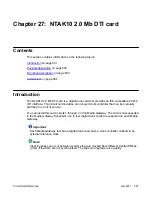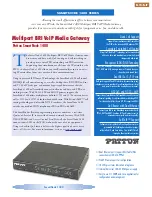
There are two stages to clock controller tracking:
• tracking a reference
• locking on to a reference
When tracking a reference, the clock controller uses an algorithm to match its frequency to the
frequency of the incoming clock. When the frequencies are almost matched, the clock
controller locks on to the reference. The clock controller makes small adjustments to its own
frequency until both the incoming and system frequencies correspond.
If the incoming clock reference is stable, the internal clock controller tracks it, locks on to it,
and matches frequencies exactly. Occasionally, environmental circumstances cause the
external or internal clocks to vary. When this happens, the internal clock controller briefly enters
the tracking stage. The green LED flashes until the clock controller is locked on to the reference
again.
If the incoming reference is unstable, the internal clock controller continuously tracks, and the
LED continuously flashes green. This condition does not present a problem. It shows that the
clock controller is continually attempting to lock onto the signal. If slips occur, there is a problem
with the clock controller or the incoming line.
Free-run (non-tracking)
In free-run mode, the clock controller does not synchronize on any outside source. Instead, it
provides its own internal clock to the system. This mode can be used when the system acts
as a master clock source for other systems in the network. Free-run mode is undesirable if the
system is intended to be a slave to an external network clock. Free-run mode can occur when
both the primary and secondary clock sources are lost due to hardware faults or invoked using
software commands.
Physical description
Faceplate LEDs
Each motherboard has five DTI/PRI LEDs and one clock controller LED. The clock controller
LED is dual-color (red and green). The clock controller LED states are described in
on page 516.
Physical description
Circuit Card Reference
July 2011 515
Summary of Contents for 1000 Series
Page 1: ...Circuit Card Reference Nortel Communication Server 1000 7 0 NN43001 311 04 04 July 2011 ...
Page 20: ...20 Circuit Card Reference July 2011 ...
Page 30: ...Introduction 30 Circuit Card Reference July 2011 Comments infodev avaya com ...
Page 116: ...Option settings 116 Circuit Card Reference July 2011 Comments infodev avaya com ...
Page 143: ...Figure 25 CP PIV card front Physical description Circuit Card Reference July 2011 143 ...
Page 148: ...NT4N39AA CP Pentium IV Card 148 Circuit Card Reference July 2011 Comments infodev avaya com ...
Page 287: ...Figure 86 Clock Controller Option 3 Operation Circuit Card Reference July 2011 287 ...
Page 302: ...NT5K21 XMFC MFE card 302 Circuit Card Reference July 2011 Comments infodev avaya com ...
Page 346: ...NT6D80 MSDL card 346 Circuit Card Reference July 2011 Comments infodev avaya com ...
Page 353: ...Figure 96 NTDK16 DLC Functional description Circuit Card Reference July 2011 353 ...
Page 461: ...Figure 147 Paging trunk operation Applications Circuit Card Reference July 2011 461 ...
Page 462: ...NT8D15 E and M Trunk card 462 Circuit Card Reference July 2011 Comments infodev avaya com ...
Page 500: ...NTAK09 1 5 Mb DTI PRI card 500 Circuit Card Reference July 2011 Comments infodev avaya com ...
Page 512: ...NTAK10 2 0 Mb DTI card 512 Circuit Card Reference July 2011 Comments infodev avaya com ...
Page 534: ...NTAK79 2 0 Mb PRI card 534 Circuit Card Reference July 2011 Comments infodev avaya com ...
Page 550: ...NTBK22 MISP card 550 Circuit Card Reference July 2011 Comments infodev avaya com ...
Page 560: ...NTBK50 2 0 Mb PRI card 560 Circuit Card Reference July 2011 Comments infodev avaya com ...
Page 595: ...Figure 165 MGC block diagram Introduction Circuit Card Reference July 2011 595 ...
Page 662: ...NTRB21 DTI PRI DCH TMDI card 662 Circuit Card Reference July 2011 Comments infodev avaya com ...
Page 668: ...NTVQ01xx Media Card 668 Circuit Card Reference July 2011 Comments infodev avaya com ...
Page 700: ......
















































